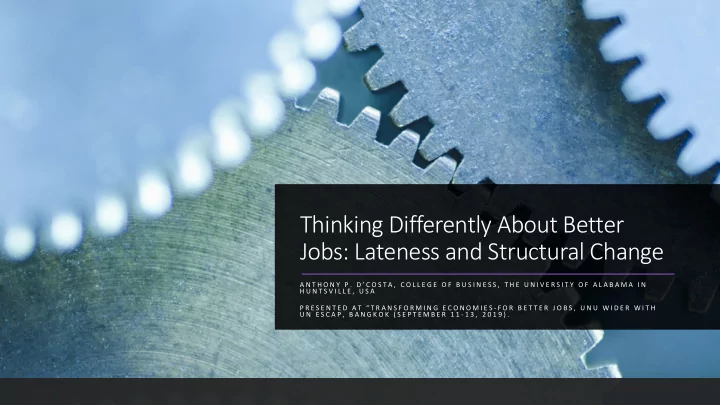

Thinking Differently About Better Jobs: Lateness and Structural Change A N T H O N Y P . D ’ C O S T A , C O L L E G E O F B U S I N E S S , T H E U N I V E R S I T Y O F A L A B A M A I N H U N T S V I L L E , U S A P R E S E N T E D A T “ T R A N S F O R M I N G E C O N O M I E S - F O R B E T T E R J O B S , U N U W I D E R W I T H U N E S C A P , B A N G K O K ( S E P T E M B E R 1 1 - 1 3 , 2 0 1 9 ) .
Prelude: Lateness and employment job prospects Rich-country experience of jobless growth experienced late industrialization in labor-abundant India, growth is unhinged from employment Late industrialization as a process of development is different from early industrialization Classical structural transformation from agriculture to industry is no longer tenable because of the type of “lateness” Also, agrarian question no longer on the agenda Persistence of the informal sector, informalization of the formal Services transformation limited due to skill-, education, and technology-bias Need to think differently about jobs 1
Why lateness is a challenge for good jobs in India • Industrialization space crowded (Asian industrialization: China, SE Asia, and East Asia) • Services revolution is not as labor-absorbing as manufacturing • Lack of agrarian transformation and pre-mature deindustrialization leading to self-employment and casual work Outline of the Examine nature of jobless growth paper • Employment elasticities • Dominant explanations An alternative historical-structural explanation (HES) Rethinking structural change for employment 2
Output and Employment Growth and Employment Elasticities (1981-82 to 2004-05) A. Employment creating Growth in Gross Value Growth in Employment (% Employment Elasticity growth Added (% per year) per year) Wearing apparel 15.5 0.71 0.64 Leather tanning 6.93 3.54 0.51 Paper, paper products 3.84 1.24 0.32 Rubber, plastics 11.28 3.96 0.35 Furniture, manufactures 8.06 5.37 0.67 Total of A 8.64 2.26 0.26 B. Job displacing growth Textiles 4.96 -0.53 -0.11 Wood, wood products 0.09 -1.57 -16.55 Publishing, printing 0.35 -1.44 -4.07 Basic metals 7.13 -0.09 -0.01 Other transport 6.79 -2.44 -0.36 Total of B 6.05 -0.45 -0.07 All manufactures 7.41 0.78 0.10 Source: Annual Survey of Industries in Kannan and Raveendran 2009: 84. 3
Net Increase in Sectoral Employment and GDP Growth (2004-05 to 2009-10) Net Increase in Growth of GDP (%) Employment (millions) Agriculture, etc. -21.1 4.1 Mining and quarrying 0.4 Manufacturing -3.7 10.5 Electricity, gas, water 0.0 Services and construction 25.0 10.5 Construction 18.1 9.6 Trade, hotels, transport, 3.9 10.5 communication Finance, real estate, business 2.3 13.4 services Community, social, and 0.7 8.0 personal services Total (employment & GDP) 1.2 8.6 Contribution of Manufacturing to GDP 18.7% Source: NSSO in Thomas (2012): 41. And to employment -16.6% during same period) 4
Persistence of the informal sector (non-wage employment) Inability of the formal sector to create jobs Some ◦ Not deep enough economic reforms hypothetical ◦ Labor market reforms (but already circumventing through contract labor, under hiring and adopting capital-intensive methods) ◦ If 90% of garment firms 8 or fewer workers then could hire more since IDA kicks in for reasons for 100 workers or more ◦ Supply bottlenecks jobless ◦ Credit, electricity, inputs ◦ Ease of doing business growth ◦ Corporate business strategies ◦ Capital-intensive production (rising capital-labor ratio) ◦ Squeezing workers by hiring few 5
Agrarian transition is incomplete, lagging (no Lewisian turn) State’s “big push” with industry for transformation exhausted despite leapfrogging in some sectors (regulation, declining Historical investment) structural Enclave modern economy in the midst of persistent informal sector (labor reservoir) explanation Symbiotic relationship between the formal and informal sectors Structural stalemate of compressed capitalism (advanced, lagging, persistent sectors) 6
Structural Stalemate Under Late Industrialization (HES) No Agrarian Transition Non-linear & Simultaneity Late Industrializers Uneven State Capitalism Development Capitalist Maturity (dualism, Pre-mature enclave) deindustrialization Primitive Persistence of Petty State Capitalism Commodity Production Accumulation Capitalist Maturity Advanced Capitalist Countries Linear Progression toward Maturity Source: D’Costa, A.P. (2016). Compressed Capitalism, Globalisation and the Fate of Indian Deveopment, in S. Venkateswar and S. Bandyopadhyay (eds) Globalisation and the Challenges of Development in Contemporary India, Singapore: Springer, pp. 19-39. 7
Jobless growth with 16 million new jobs a year needed plus 120 m surplus and unemployed Cheapening of capital that encourages capital-intensive production GVCs are well-established, recent tariff war could rearrange GVCs but India may not be the place Structural change of the Lewisian kind ruled out, focus on long term gradual shifts through labor-intensive simple production and services jobs, a “place-holding” strategy while sorting out social transformation Rethinking Not just investment but also lack of purchasing power employment In addition to the usual forms of intervention from the supply side (the EODB in India) ◦ Focus on the handloom sector to sustain jobs that already exist through branding/marketing (see Viswa Banga), 7 million direct and indirect employment (75% SC/ST, OBCs, women) ◦ Focus on the underleveraged tourism sector (48.9 m in 2004; 37.3 m in 2015, Turkey with 80 m people attracted 40 million foreign tourists) ◦ Political rebalancing of state-business relationship in favor of workers 8
Recommend
More recommend